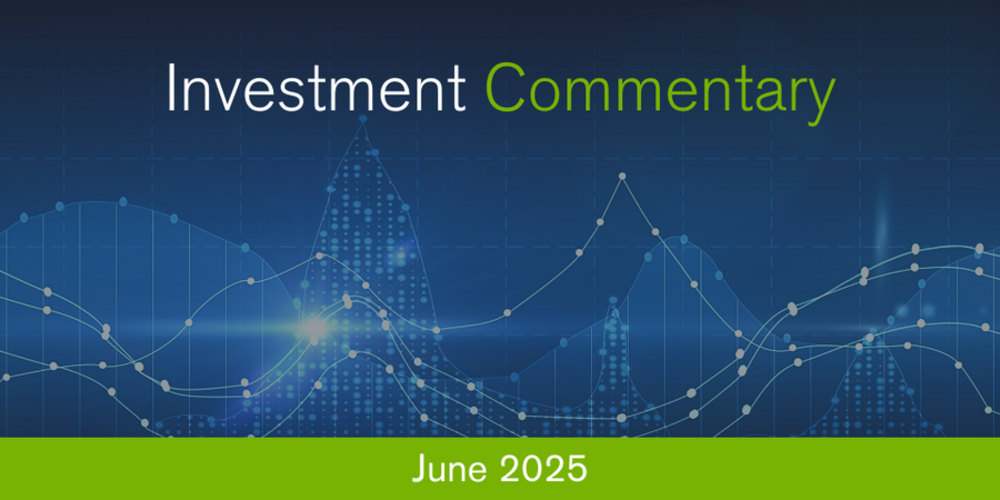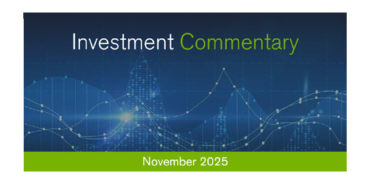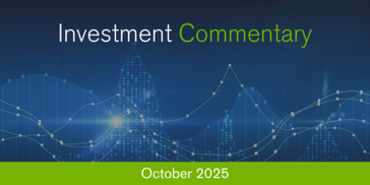Investment Commentary - June 2025

Markets continued to look through any political noise in June as risk assets enjoyed further gains, with many markets reaching record highs once more. Looking at the quarter as a whole, the strong returns disguised what was an extremely volatile period, with much uncertainty thrown up. This uncertainty did recede somewhat as the quarter went on, with further trade deals announced between the US and other countries. Furthermore, there were few signs that tariffs put in place at the beginning of April were having a material impact on inflation, which continued to cool in developed markets. This, combined with a resilient global economy and lessening geopolitical worries, were enough for investors to push equity markets to new highs.
Perhaps the biggest story within the asset classes was the continued weakening of the US Dollar, which had its worst H1 performance since 1973, with the Dollar Index falling by -7% in Q2 and taking the year-to-date decline into double figures. There were numerous factors contributing to this weakness, however, the main drivers appear to be unfunded economic policies within Trumps ‘big, beautiful bill’, the unpredictable and stop-start nature of Trump’s tariff threats, his attacks on the Chair of the Federal Reserve and further bets on US interest rate cuts this year and next. All of these factors have raised questions about the attractiveness of the Dollar and its safe haven status.
For equities, June was a period where previously underperforming markets – on a year-to-date basis - caught up. The US and Japan both enjoyed strong returns, with the S&P 500 and Nikkei up +5.1% and +6.8% respectively. Europe had a relatively flat month, with the DAX down slightly. The FTSE 100 was also flat in June. Asian markets performed well, with the Hang Seng returning 4.1% and the broader MSCI Emerging Markets Index up +6.1%. For the quarter, one of the best performing indices was the Nasdaq, which was up +18%, bouncing back from a difficult Q1. The S&P also managed a double-digit gain. European markets added to their strong Q1 gains, with the main German, Spanish and Italian equity markets all having returned more than twenty percent in the first half of the year. The bounce-back in Q2 for global growth stocks prompted a significant narrowing of the performance gap versus global value stocks, with growth outperforming value by approximately 12% during Q2. Value has returned slightly more than growth for H1 however (+10.9% versus +8.7%), and exhibited significantly less volatility during the period.
Despite some weakness at the long-end of the global bond markets and subsequent curve steepening, June and Q2 produced solid returns for fixed income investors on aggregate. Gilts and US Treasuries were the better performers in June, returning +1.6% and +1.3% respectively. European sovereign bonds were slightly negative at -0.2%. This underperformance took the shine off what was a strong Q2 (+1.9%), putting them behind Gilts (+2%) but ahead of Treasuries (+0.8%). For H1, European sovereign bond returns (+0.6%) now lag Gilts (+2.5%) and US Treasuries (+3.5%) by a significant margin, with the ECB seen at a fairly advanced stage in its interest rate cutting cycle compared to other major central banks (Japan excepted). Investment-grade corporate bonds outperformed their equivalent sovereigns in June as credit spreads continued to narrow. This put Q2 returns at a broadly similar level versus sovereign bonds.
For commodities, barring softs such as sugar and corn, June was a period of strong returns, with the broad CRB Commodity Index returning +2.4% and +3.9% for the quarter as a whole. Industrial metals continued their strong year, with copper up +7.5% during the month and completing the recovery from the significant sell-off in April, with a flat return for Q2. A very strong performance in June helped silver catch up to the returns of gold. Silver was up +9.5% during the month, while gold could only manage +0.4%. This took silver’s, Q2 return to +5.9% (slightly ahead of gold’s +5.7%). The oil price bounced back in June (+7.1% for WTI and +5.8% for Brent), however, it was not enough to recover fully from the slide in April and both finished the quarter significantly down (-8.9% for WTI and -9.5% for Brent).
Aside from the aforementioned US Dollar weakness, the main movers within the G10 currencies were the Euro, which strengthened against its peers (by +3.9%), and the Yen, which weakened in a similar fashion to the Dollar (it was flat versus the dollar in June). Sterling managed to gain against these weaker currencies (by around +2%) but fell versus the Euro (by around -1.8%).
- Date
- 24/07/2025





